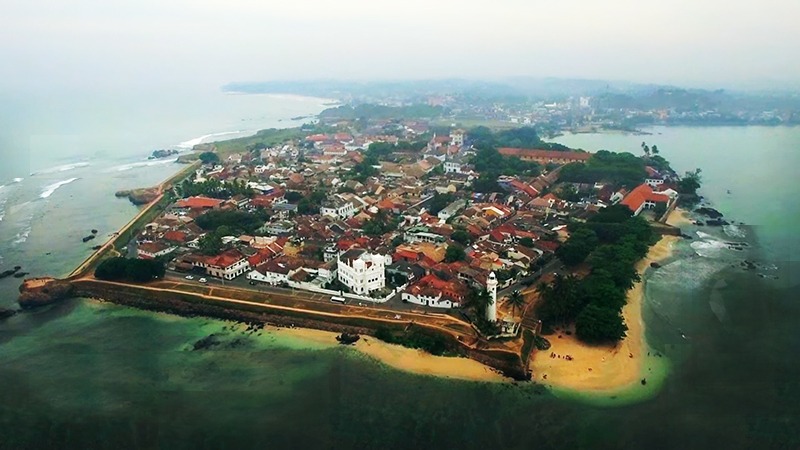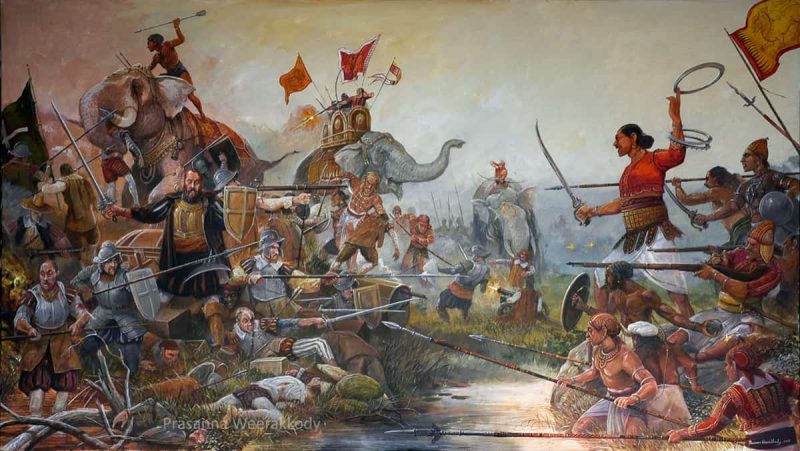Arrival Of Portuguese In Sri Lanka
Arrival Of Portuguese In Sri Lanka
In 1505 eight years after Vasco da Gama had doubled the Cape of Good Hope when Vira Parakrama Bahu 8 was king of Kottw, Vikrama Bahu, king of the Hill Country, and Pararasa Sekaran, king of Jaffna, a Portuguese fleet was forced by winds and waves to the island of Ceylon. The captain-major of the fleet was a young nobleman named Don Lourenco de Almeida, son of the first Portuguese viceroy of India.
He had set out from Cochin to intercept the richly laden Muslim ships which, bound from China to the Persian Gulf, were avoiding the usual route, now infested by the Portuguese and were passing by the Maldives Island.
Being caught in a storm, Don Lourenco was tossed to the southern coast of Ceylon unawares and put into the harbour of Galle (about Galle). When he learned that this unknown country was the far-famed island of Ceylon, he coasted on to Colombo which he was told was the port to the capital of the island.

Colombo
Colombo, then called Kolamba or Kolomtota, was the chief anchorage for ships and the mart of the island’s trade. This trade, chiefly in cinnamon, coconut, and elephants was in the hands of Muslim traders, the descendant of the seafaring Arabs. They had many storehouses of bangasalas in which they stocked their merchandise.
The population of the town was largely Muslim, and there was a mosque together with a Muslim cemetery and a court of justice to settle disputes according to Muslim law. The township lay on the bank of a rivulet, an outlet of the Kelani River, which entered the sea near the modern Pettah. Over the rivulet was a bridge, and large and broad streets intersected the town. At the mouth of this rivulet, there was a fairly safe anchorage for ships.
Muslims
The Muslims were an object of hatred to the Portuguese. The latter was Christians, the former Mohammedans, and between the two for many centuries past had raged the wars known as the Crusades. Moreover, the object of the Portuguese explorations was to wrest the trade of India and its profit from the Muslims who had been masters of Indian seas for many centuries.
Nowadays rival traders oust each other by peaceful competition, but in those rough times, they did so by sheer might and open piracy. The Portuguese and the Muslims, therefore, fought each other wherever they met, and merchantmen always carried guns and generally sailed together for common help.
Trade rivals
When Don Lourenco appeared off Colombo, there were Muslims ships engaged in lading or Landing cargo, and all took alarm at the unexpected appearance of the hated rival. The captain-major, however, who had so recently been storm-tossed and had come to hold communication with the king of the country, did not wish to be hostile and assured the Muslims of his peaceful intentions.
He had heard of Ceylon, of its spices and elephants and pearls and his king had even directed his father, the viceroy, to explore Ceylon. Glad, therefore, to have come unexpectedly upon the island, he desired to send an embassy to the king, and sought information from the Muslim captains.
They were not disposed to let their rivals know how fruitful and fair this island was, and tried to dissuade the Portuguese commander from entering into negotiations with the Sinhalese king. At their instigation, the townspeople of Colombo set upon a party of the sailor who had gone on shore for wood and water, but a volley from the ship’s cannon soon cleared the shores.
Vasco Da Gama arrived in Sri Lanka in 1505 and the King of Sri Lanka was Vira Parakrama Bahu. The king was informed upon the arrival of strangers to the port of Colombo. According to a Sinhalese chronicle, the Rajavaliya, the message was counched in this form.
“There is in our harbour of Colombo a race of people, fair of skin and comely withal. They don jackets and hats of iron; rest not a minute in one place but walk here and there. They eat hunks of stone and drink blood. They give two or three pieces of gold and silver for one fish or one lime. The report of their cannon is louder than thunder when it burst upon the rock of Yugandhara.
The king promptly summoned his council and on its advice decided to receive the newcomer. Messengers were accordingly sent with the fruit of the country to bid the visitors welcome in the name of the king.
Don Lourenco was so pleased with the message that he dispatched Fernao Custrim, one of the captains of the fleet, as an envoy to Kotte. The royal councillors, however, had thought it unsafe to let the foreigner see that Kotte was so near Colombo, and the Portuguese envoy was led by a circuitous route, uphill and down dale, for three days.
The people of Ceylon who heard about the ruse thought that the Portuguese were misled and to this day a circuitous route is called in Sinhalese “ as the Portuguese went to Kotte”, But a ship’s captain who had found his way over the wide ocean from Lisbon to India could not be easily deceived in his bearings.
Don Lourenco, moreover, had taken the precaution of retaining hostage for the safe return of his envoy and had agreed to fire a gun at every turn of the hour-glass. From the report of the gun, Cutrim saw quite clearly that he was being led in a roundabout way but took no notice, as no harm seemed to be intended.
He was commissioned to pay the commander’s compliments and inquire whether the king would enter into a treaty with Portuguese. Though he did not see the king or converse with him he was assured that the king would be pleased to form an alliance. With this message, Curtrim returned along with some of the king’s people and elephants to conduct an ambassador.
Payo de Souza was thereupon chosen by Don Lourenco to wait upon the king to negotiate a treaty. To understand the object of this treaty one must know the purpose of the Portuguese was the trade, and that trade, and that trade a monopoly. The kings and princes of India were invited to give this monopoly to the king of Portugal, in return for the protection of their shores.
If they accepted, a treaty was drawn up expressing this bargain in terms of feudal vassalage. Such a treaty Payo de Souza proposed to the king of Kotte at an audience. Of, this the first European embassy to a Sinhalese king, there exists a classic description given by the king of Portugal to the Pope of Rome when he announced to the pointiff the discovery of Taprobane.
King of Kotte and Portuguese grip on Sri Lanka
The nominal emperor of Ceylon at the arrival of Portuguese in Sri Lanka was Vira Parakrama Bahu (1484-1509) who was an old man and had entrusted the government of his realm to his sons. The eldest afterwards Dharma Parakrama Bahu, ruled at Kotte; Vijaya Bahu was at Dondra in the south, Rajasinghe was at Menikkadavara in the Four Korales, and another whose name is not known at Raigama.
Two of the king’s nephews, Sakalakala Valla and Taniya Valla, ruled at Udugampola and Madampe. The two elder sons were rival claimants to the empire and both assert in their grants that they were the Chakravarti of Ceylon in the year 1509, which is apparently the year of their father’s death.
Vira Parkarama Bahu’s reign was disturbed in various ways. A Malabar pirate from Kayalpatanam invaded the north-west coast and fished for the Gulf of Mannar. The princes of Madampe and Udugampola marched against him with a large force of man and elephants and utterly defeated the Malabars.
Vikrama Bahu, the king of the hill-country, began to assert his independence by withholding the usual tribute, but the prince of the Four Korale invaded his kingdom and demanded the payment of two lacks of fanams and elephants and the king’s daughter to wife, subsequently, he made an attempt to invade the Four Korales, but was again subdued by the prince of Udugampola and forced to send a pearl umbrella, a couch, a shield, and a necklace.
On the death of the aged king, the two elder sons disputed the succession. Dharma Parakrama Bahu, who had been ruling at Kotte in his father’s lifetime and had received the Portuguese ambassador, had many supporters in Kotte. Wishing to obtain Portuguese troops to intimidate his brother, he sent a message to the viceroy fro troops and offered to give a site for a fortress in Colombo. As the Portuguese were too busy at the time, nothing came of the offer.
The Portuguese were then engaged in trying to oust the Muslim rival from the Indian waters by erecting fortresses at Malacca, Ormuz, and Aden. Malacca, situated between Sumatra and the Malay Peninsula, commanded the Indian trade with China.
Ormuz commanded the sea route to Basra through the Persian Gulf and the caravan traffic from Basra to Aleppo, Trebizond, and Damascus, whence Venetian ships fetched the Indian products for distribution in Europe. Aden, in like manner, guarded the sea route to Suez whence merchandise was carried by camels to Cairo and down the Nile to Alexandria and finally to Venice. Thus Malacca, Ormuz, and Aden were the keys to the Indian trade.
Alfonso de Albuquerque, who had succeeded Almeida as viceroy, made Goa the headquarters of the Portuguese state in India and fortified Malacca and Ormuz. His successor, Lopo Soarz, de Albergaria, endeavoured to take Aden, but failing in this he hastened to carry out the orders he had received from his to erect a fortress in Ceylon which lay on the trade route to the Far East and was the well-known landmark of Eastern navigation.






